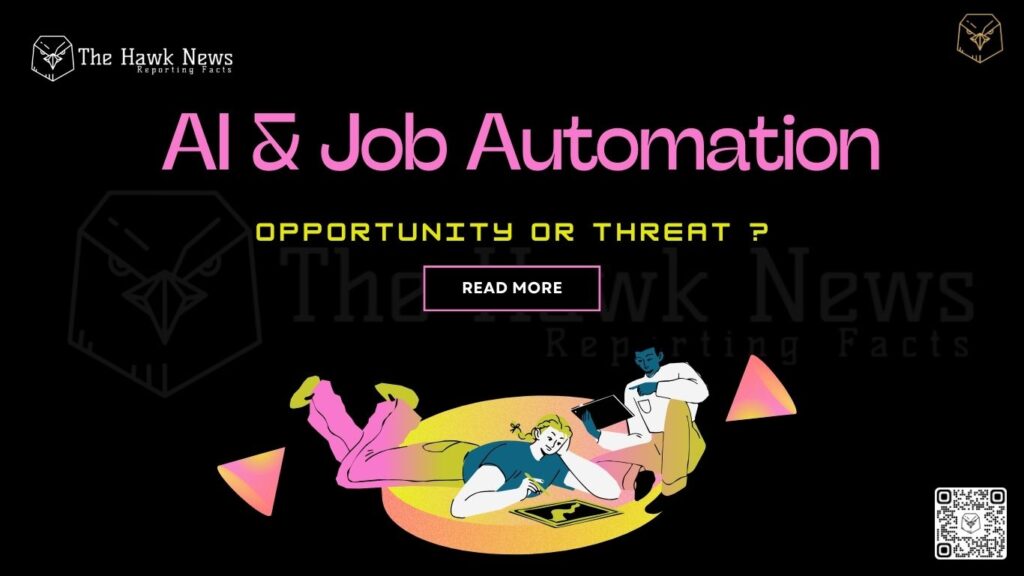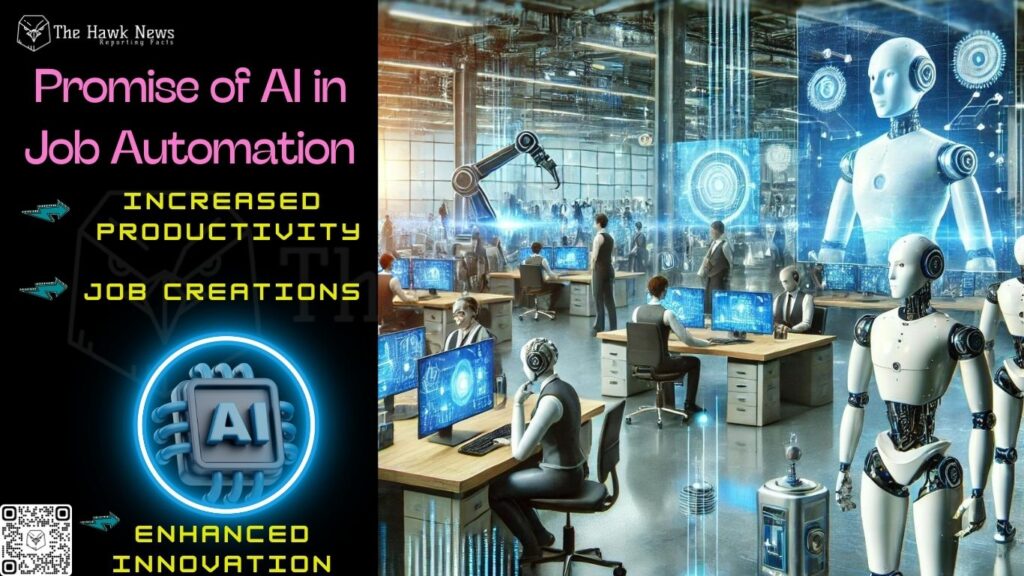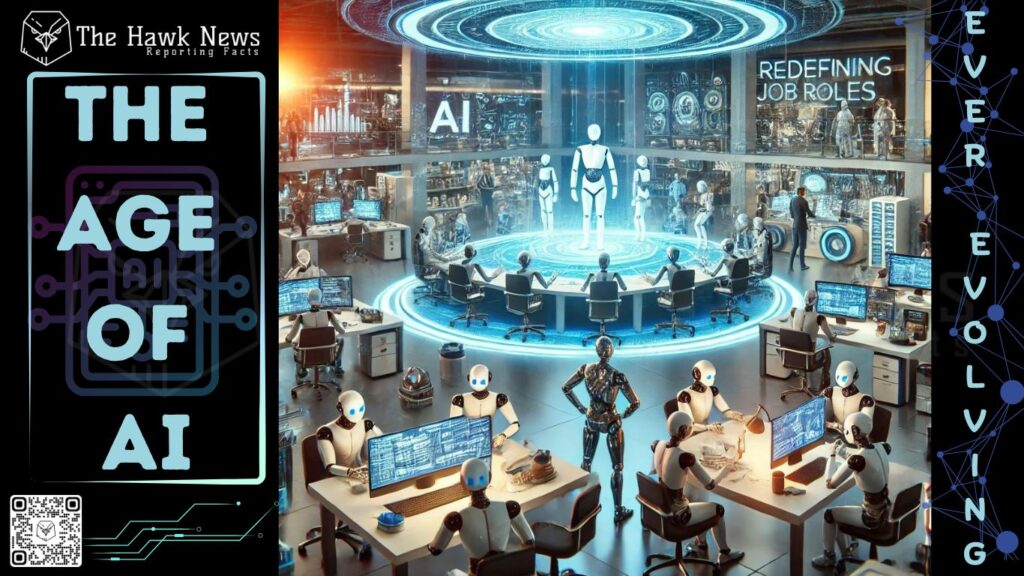
As artificial intelligence (AI) and machine learning continue to advance, they are rapidly transforming industries and reshaping the workforce. From automating routine tasks to enhancing decision-making processes, AI offers numerous opportunities for efficiency and innovation.
However, this technological revolution also raises significant concerns about job displacement, the future of work, and economic inequality. The question of whether AI represents an opportunity or a threat to the workforce of tomorrow is complex and multifaceted.
This article provides a comprehensive examination of the effects of AI and job automation on job roles, job security, and society. It thoroughly explores the potential benefits and challenges associated with these technological advancements.
The Promise of AI in Job Automation

AI and automation have the potential to revolutionize the workplace by taking over repetitive, mundane tasks, allowing human workers to focus on more complex and creative activities. This shift can lead to increased productivity, cost savings, and the creation of new job opportunities in emerging fields.
- Increased Efficiency and Productivity: One of the most significant advantages of AI in the workplace is its ability to perform tasks with greater speed and accuracy than humans. For example, AI-powered systems can analyze vast amounts of data in seconds, enabling businesses to make quicker and more informed decisions.
In manufacturing, robots equipped with AI can work tirelessly around the clock, increasing production rates and reducing the risk of human error.
- Job Creation in New Fields: While AI may eliminate some jobs, it also creates new opportunities in sectors that require human oversight, creativity, and technical expertise.
For instance, the development and maintenance of AI systems require skilled workers in areas such as data science, software engineering, and AI ethics. Additionally, AI is driving growth in industries such as cybersecurity, digital marketing, and healthcare, where specialized knowledge and human intuition are still essential.
- Enhanced Innovation: AI can also be a catalyst for innovation by enabling new products, services, and business models. For example, AI-driven personalization in e-commerce has led to the creation of highly tailored customer experiences, driving sales and customer loyalty.
In healthcare, AI is being used to develop personalized medicine and advanced diagnostic tools, leading to better patient outcomes and the potential for new treatments.
The Threat of Job Displacement
Despite the potential benefits, AI and automation pose significant challenges, particularly regarding job displacement and economic inequality. As machines take over tasks traditionally performed by humans, there is a growing concern that many workers will be left behind, leading to widespread unemployment and social unrest.

- The Risk of Job Loss: One of the most pressing concerns about AI and automation is the potential for widespread job loss. According to a report by the World Economic Forum, automation could displace around 85 million jobs globally by 2025. Jobs in industries such as manufacturing, retail, and transportation are particularly vulnerable, as these sectors rely heavily on routine tasks that can be easily automated. For example, self-checkout systems in retail stores and automated assembly lines in manufacturing have already led to job reductions in these industries.
- Economic Inequality: The displacement of low-skilled workers by AI could exacerbate existing economic inequalities. Workers who lose their jobs to automation may struggle to find new employment, particularly if they lack the skills needed for emerging roles in the AI-driven economy. This could lead to a growing divide between those who can adapt to the new technological landscape and those who cannot, resulting in increased income inequality and social division.
- The Need for Reskilling and Education: To mitigate the impact of job displacement, there is an urgent need for reskilling and education programs that equip workers with the skills required for the jobs of the future. Governments, businesses, and educational institutions must collaborate to provide training in areas such as data analysis, AI programming, and digital literacy. Without these efforts, many workers may find themselves unable to compete in the rapidly changing job market.
Redefining Job Roles in the Age of AI

As AI continues to evolve, it is not only changing the types of jobs available but also redefining existing roles. Many jobs that once required manual labor or repetitive tasks are now becoming more focused on creativity, problem-solving, and human interaction. This shift presents both opportunities and challenges for workers and employers alike.
- The Rise of Hybrid Roles: AI is giving rise to hybrid roles that combine human skills with machine capabilities. For example, in the healthcare industry, AI can assist doctors in diagnosing diseases by analyzing medical images, while the doctor provides the final judgment based on their expertise and patient interaction.
Similarly, in marketing, AI can analyze consumer data to identify trends and preferences, while human marketers use this information to develop creative campaigns. These hybrid roles require workers to have both technical knowledge and soft skills, such as communication and emotional intelligence.
- Emphasis on Soft Skills: As AI takes over routine tasks, there is a growing emphasis on soft skills that machines cannot replicate. Creativity, empathy, critical thinking, and leadership are becoming increasingly valuable in the AI-driven workplace.
For example, while AI can generate data-driven insights, it is up to human workers to interpret these insights and make strategic decisions. As a result, workers who excel in these areas are likely to thrive in the new job landscape.
- The Role of Human Judgment: Despite the advancements in AI, human judgment remains crucial in many areas of work. In industries such as law, education, and healthcare, decisions that require ethical considerations, empathy, and understanding of complex human emotions cannot be fully automated.
AI can support these roles by providing data and analysis, but the final decisions still rest with humans. This underscores the importance of human intuition, experience, and moral reasoning in the workplace.
Balancing the Opportunities and Threats
As we move further into the digital era, it is essential to strike a balance between embracing the opportunities presented by AI and addressing the potential threats. Policymakers, business leaders, and workers must work together to ensure that the benefits of AI are distributed equitably and that the risks are managed effectively.
- Responsible AI Development: One way to achieve this balance is through the responsible development and deployment of AI technologies. Companies must ensure that AI systems are designed and implemented in ways that promote fairness, transparency, and accountability. This includes addressing biases in AI algorithms, ensuring data privacy, and preventing the misuse of AI in areas such as surveillance and decision-making.
- Social Safety Nets: To protect workers who may be displaced by automation, governments should strengthen social safety nets, such as unemployment benefits, retraining programs, and job placement services. These measures can help workers transition to new roles and reduce the economic and social impact of job loss.
- Collaboration Between Stakeholders: Finally, collaboration between governments, businesses, educational institutions, and workers is essential for navigating the challenges of AI and job automation. This includes developing policies that support job creation in new sectors, investing in education and reskilling programs, and promoting lifelong learning to ensure that workers can adapt to changing job requirements.
Conclusion

The rise of AI and job automation presents both opportunities and threats for the workforce of tomorrow. While AI has the potential to increase productivity, create new jobs, and drive innovation, it also poses significant risks, including job displacement and economic inequality.
The key to harnessing the power of AI lies in balancing these opportunities with the potential threats, ensuring that the benefits are shared broadly and that workers are equipped with the skills needed to thrive in the new economy.
By embracing responsible AI development, strengthening social safety nets, and fostering collaboration between stakeholders, we can create a future where AI enhances human work rather than replacing it. The workforce of tomorrow will undoubtedly be shaped by AI, but with careful planning and thoughtful action, it can be a future that offers opportunities for all.